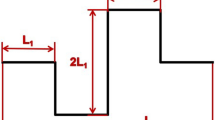Abstract
In this paper, we design a novel low voltage of electroosmotic micromixer with fractal structure. Because of the influence of high voltage on electrode and solution, we propose an electroosmotic micromixer of low voltage. In order to optimize the electrode position, we design the Cantor fractal according to Cantor principle, and arrange the electrode pairs on the fractal. Then we study the mixing effect of the electrode pairs length on the mixing performance, the effect of the electrode position and the effect of fractal electrode group spacing on the mixing efficiency. When the electroosmotic micromixer has three electrode groups at alternating voltage of 5 V and alternating frequency of 8 Hz, the best mixing efficiency can reach 95.2% in one second. We call this micromixer Cantor fractal electroosmotic micromixer (CFEM). At the same Re, the mixing efficiency of CFEM is higher than the electrodeless micromixer 50%.














Similar content being viewed by others
References
Ahmed F, Kim KY (2017) Parametric study of an electroosmotic micromixer with heterogeneous charged surface patches. Micromachines 8(7):199
Chau JLH, Leung AYL, Yeung KL (2003) Zeolite micromembranes. Lab Chip 3(2):53–55
Chen Xueye, Li Tiechuan (2017) A novel passive micromixer designed by applying an optimization algorithm to the zigzag microchannel. Chem Eng J 313:1406–1414
Chen X, Zhang L (2017a) A review on micromixers actuated with magnetic nanomaterials. Microchimica Acta 184(10):3639–3649 (3(3))
Chen X, Zhang L (2017b) Review in manufacturing methods of nanochannels of bio-nanofluidic chips. Sens Actuators B Chem 1:1. https://doi.org/10.1016/j.snb.2017.07.139.7X
Chen X, Zhao Z (2017) Numerical investigation on layout optimization of obstacles in a three-dimensional passive micromixer. Analytica Chimica Acta 964:142–149 (7(3))
Chen H, Zhang Y, Mezic I et al (2003) Numerical simulation of an electroosmotic micromixer. ASME Publ FED 259:653–658
Chen X, Shen J, Hu Z, Huo X (2016a) Manufacturing methods and applications of membranes in microfluidics. Biomed Microdevice 18(6):1–13
Chen X, Li T, Zeng H, Hu Z, Fu B (2016b) Numerical and experimental investigation on micromixers with serpentine microchannels. Int J Heat Mass Transf 98:131–140
Chen X, Li T, Shen J et al (2016c) Fractal design of microfluidics and nanofluidics—a review. Chemom Intell Lab Syst 155:19–25
Chen X, Li T, Shen J, Hu Z (2017) From structures, packaging to application: a system-level review for micro direct methanol fuel cell. Renew Sustain Energy Rev 80:669–678 (6(2))
Forouzanfar S, Talebzadeh N, Zargari S et al (2015) The effect of microchannel width on mixing efficiency of microfluidic electroosmotic mixer. In: Robotics and mechatronics (ICROM), 2015 3rd RSI international conference on. IEEE, 2015, pp 629–634
Green NG, Ramos A, González A et al (2000) Fluid flow induced by nonuniform ac electric fields in electrolytes on microelectrodes. I. Experimental measurements. Phys Rev E 61(4):4011
Lu LH, Ryu KS, Liu C (2002) A magnetic microstirrer and array for microfluidic mixing. Microelectromech Syst J 11(5):462–469
Lu P, Liu X, Zhang C (2017) Electroosmotic flow in a rough nanochannel with surface roughness characterized by fractal Cantor. Micromachines 8(6):190
Nimafar M, Viktorov V, Martinelli M (2012) Experimental investigation of split and recombination micromixer in confront with basic T-and O-type micromixers. Int J Mech Appl 2(5):61–69
Niu X, Wen W, Liu L et al (2006) Active microfluidic mixer chip. Appl Phys Lett 88(15):153508
Oddy MH, Santiago JG, Mikkelsen JC (2001) Electrokinetic instability micromixing. Anal Chem 73(24):5822–5832
Sasaki N, Kitamori T, Kim HB (2010) Experimental and theoretical characterization of an AC electroosmotic micromixer. Anal Sci 26(7):815–819
Shi YZ, Xiong S, Zhang Y et al (2018a) Sculpting nanoparticle dynamics for single-bacteria-level screening and direct binding-efficiency measurement. Nat Commun 9(1):815
Shi Y, Xiong S, Chin LK et al (2018b) Nanometer-precision linear sorting with synchronized optofluidic dual barriers. Sci Adv 4(1):eaao0773
Simonnet C, Groisman A (2005) Chaotic mixing in a steady flow in a microchannel. Phys Rev Lett 94(13):134501
Yin Z (2018) Rapid prototyping of PET microfluidic chips by laser ablation and water-soaking bonding method. Micro Nano Lett 13(9):1302–1305
Yin Z, Zou H (2017) Multilayer patterning technique for micro-and nanofluidic chip fabrication. Microfluid Nanofluid 21(12):174
Yin Z, Cheng E, Zou H (2018) Fast microfluidic chip fabrication technique by laser erosion and sticky tape assist bonding technique. J Nanosci Nanotechnol 18(6):4082–4086
Yoon MS, Kim BJ, Sung HJ (2008) Pumping and mixing in a microchannel using AC asymmetric electrode arrays. Int J Heat Fluid Flow 29(1):269–280
Zadeh HF (2005) Experimental validation of flow and mass transport in an electrically-excited micromixer. Wissenschaftliche Berichte FZKA 7152
Zhou T, Wang H, Shi L et al (2016) An enhanced electroosmotic micromixer with an efficient asymmetric lateral structure. Micromachines 7(12):218
Zhou T, Ge J, Shi L et al (2018a) Dielectrophoretic choking phenomenon of a deformable particle in a converging-diverging microchannel. Electrophoresis 39(4):590–596
Zhou T, Deng Y, Zhao H et al (2018b) The mechanism of size-based particle separation by dielectrophoresis in the viscoelastic flows. J Fluids Eng 140(9):091302
Acknowledgements
This work was supported by The Key Project of Department of Education of Liaoning Province (JZL201715401), Liaoning Province BaiQianWan Talent Project. We sincerely thank Prof. Chong Liu for his kind guidance.
Author information
Authors and Affiliations
Corresponding author
Additional information
Publisher's Note
Springer Nature remains neutral with regard to jurisdictional claims in published maps and institutional affiliations.
Rights and permissions
About this article
Cite this article
Wu, Z., Chen, X. Numerical simulation of a novel microfluidic electroosmotic micromixer with Cantor fractal structure. Microsyst Technol 25, 3157–3164 (2019). https://doi.org/10.1007/s00542-019-04311-8
Received:
Accepted:
Published:
Issue Date:
DOI: https://doi.org/10.1007/s00542-019-04311-8




